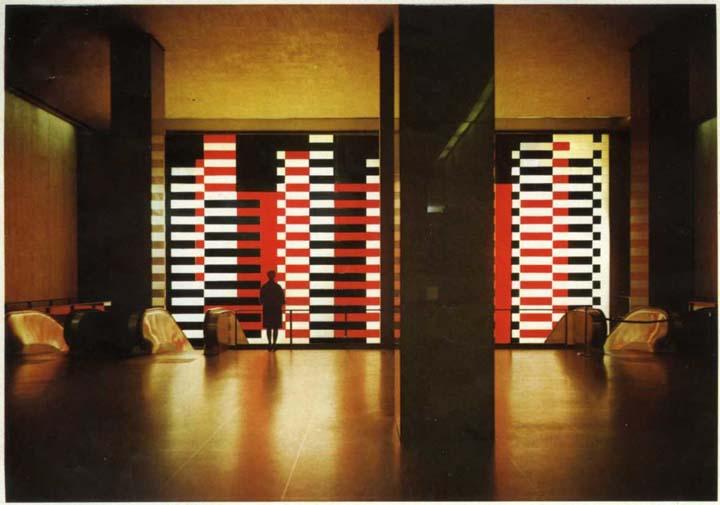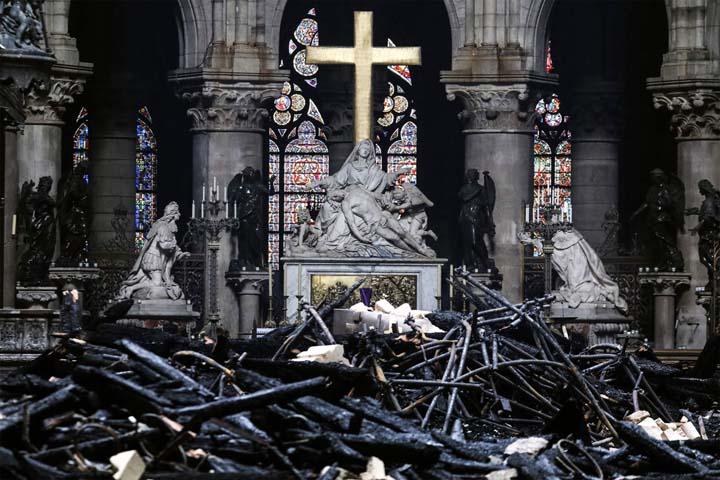The DART Board: Page Five
Josef Albers’s Famous New York Mural Returns to New York Josef Albers’s enormous Manhattan mural has returned to the lobby of the former MetLife building. The mural was a central part of the Modernist lobby of the Walter Gropius-designed building at 200 Park Avenue, and there was widespread public outcry when it was removed during a renovation in 2000. It has now been recreated in a project led by architect Raúl de Armas’s New York firm, MdeAS. As reported in the New York Times, the mural was ingrained in the design of the building. Ingrained in the mural, however, was asbestos.
And thus ended the existence of a great German artist’s ode to New York — until this week, when an exact replica of Albers’s creation was unveiled in the same spot where it last loomed nearly two decades ago. The bright patchwork, a vibrant centerpiece in the lobby, has made its long-awaited return.
“This is what art was for him: something that could affect you, maybe gave a little bit of joy to the lives of those people rushing to their trains or rushing out of the station to their workday,” said Nicholas Fox Weber, the executive director of the Josef and Anni Albers Foundation….Nearly two decades after the mural’s removal, Mr. Weber said its return has brought him “overwhelming joy.” “This mural is universal and timeless,” he said. “Time got in the way when it was destroyed, but now it’s back. It’s resurrected.” Top: An archival image of the original mural, which came down in 2000. Top: Archival image of the Josef Albers mural “Manhattan” in the lobby of 200 Park Avenue. Credit: The Josef and Anni Albers Foundation/Artists Rights Society (ARS), New York
The litigious artist Jeff Koons has again come up on the wrong side of the bench in an appeal in his latest copyright infringement case. Artforum reports that a Paris appeals court has upheld a 2017 ruling which found Jeff Koons guilty of plagiarism. It determined that Naked, a sculpture Koons created in 1988 for his “Banality” series, copied a photograph of two naked children—a little boy and a girl holding flowers—titled Enfants, by the late French photographer Jean-François Bauret. The image was also published as a postcard in 1975.
According to the Associated Press, Koons and the Centre Pompidou have been ordered to pay more than $22,000 in damages to Bauret’s heirs. Koons’s studio must compensate the family an additional $4,000 for using a picture of the sculpture on the artist’s website. Stephanie Legrand, the lawyer representing Bauret’s descendants, said: “The continued use of his image in France is banned by the court, which is a great success for my clients.”
While the sculpture was set to be on view in a major retrospective of the artist that was staged at the Centre Pompidou in November 2014, it was never installed. The piece was damaged as it was being transported to the museum. The court still found the Centre Pompidou culpable for the copyright infringement because the institution reproduced pictures of the work in advertisements and for its marketing campaign for the show. [More]
A cave painting of hunters — and their prey — discovered in Indonesia could be the world’s “oldest story,” according to a new study published in the journal Nature. Dating back nearly 44,000 years, the Paleolithic artwork proves that prehistoric humans might have been more creatively inclined than once thought, researchers say. “It completely changes the picture of our human journey,” head study author Maxime Aubert, an archaeologist at Australia’s Griffith University, tells National Geographic. Indeed, new carbon dating determined the mural to be 43,900 years old, making it the “the oldest pictorial record of storytelling and the earliest figurative artwork in the world,” say researchers.
Originally stumbled upon in 2017 by a spelunker in Sulawesi, Indonesia, the 13-foot, splotchy mural depicts two pigs, four buffalo and eight 2- to 4-inch humanoid figures. Some are brandishing what resemble ropes or spears. Previously, Europe was thought to be the birthplace of rock art, Canada’s University of Victoria archaeologist April Nowell tells National Geographic. However, this latest discovery — along with another 40,000-year-old “figurative” painting found in Borneo — suggests that Southeast Asia could be the real cave mural mecca
The Notre Dame Cathedral fire of 15 April and the cathedral’s near miraculous survival was a reminder of the vulnerability of historic buildings, particularly when repairs are under way. The challenge now is to determine the best way to restore the Paris landmark.
Monsignor Patrick Chauvet told The Associated Press yesterday that scaffolding installed before the April fire—which melted, fused and is now perched ominously above the building—is at risk of collapsing onto the three vaults. "We need to remove completely the scaffolding in order to make the building safe, so in 2021 we will probably start the restoration of the cathedral," he said. "Once the scaffolding is removed we need to assess the state of the cathedral, the quantity of stones to be removed and replaced." [more] Photo: AFP/Getty Images
Pussy Riot Announces a North American Tour – The Russian feminist art collective and punk band will tour North America in 2020. The group, which released a song No More Wire Hangers in July in Alabama to protest the state’s new anti-abortion law, will donate a share of the tour’s proceeds to Planned Parenthood. The 19-date tour starts in Los Angeles in March and ends in Toronto. Tickets, as well as a promotional video, are available on the group’s website. (Newsweek)
For the activists who had been campaigning for years to remove a New York City monument to J. Marion Sims, the 19th-century doctor who made his gynecological advances by experimenting on enslaved black women, October 5 should have been a triumph. The Sims statue was gone from its perch in Central Park, and the city was poised to select a replacement proposal from one of four esteemed black artists.
Instead, an event that night ignited further controversy, as a panel of experts voted in favor of the piece designed by the prominent artist Simone Leigh, whose work has recently been shown at the Solomon R. Guggenheim Museum and the Whitney Museum, despite vocal support from some community members for the work of Yonkers-based artist Vinnie Bagwell. Bagwell, a self-described “untutored artist,” began sculpting in 1993. Her first public commission was an Ella Fitzgerald statue for the city of Yonkers in 1996. In March, Governor Andrew Cuomo commissioned her to create a statue of Sojourner Truth for the Hudson State Historic Park in Highland, New York.
Now that Bagwell has been named as the winner of the commission, “the city will work with [her] in collaboration with local residents to refine the design,” the Department of Cultural Affairs said in a statement. The sculpture is expected to be completed in 2021. [more]
In the category of Looking Back, ArtNetNews recently polled experts on the most important exhibitions of the decade. The top results are:
“Hilma af Klint: Paintings for the Future” at the Guggenheim was the show I found most inspiring and influential this past decade. Curator Tracey Bashkoff brought our attention to an artist who was largely ignored during her own lifetime and after (partially due to her own reclusiveness). Her work transcends painting and encapsulates tenets of spirituality and meditation, without sacrificing aesthetics in the least.
—Alexander S.C. Rower, president of
the Calder Foundation
“Hilma af Klint: Paintings for the Future” at the Guggenheim and “Howardena Pindell: What Remains to Be Seen” both brought the work of important, under-recognized women artists to the fore, something that is near and dear to the Aldrich’s heart.
—Cybele Malone, executive director of the Aldrich Contemporary Art Museum
NKAME: A Retrospective of Cuban Printmaker Belkis Ayón Printmaker Belkis Ayón, at El Museo del Barrio, has been on my mind. The grace and care of the exhibition was at once an elegy to this gone-too-soon, seen-too-rarely artist, and an astoundingly beautiful exploration of her practice. Balancing a studious look at Ayón’s unique and textural approach to collography, with a riveting introduction to her re-imaginings of the male myths of Abakuá, it navigated complex subjects with an accessible, visually arresting approach, one that should serve curators well as major museums begin to give under-known women artists like Ayón a wider audience.
Installation view of “David Hammons” at Hauser & Wirth, Los Angeles. Photo: Janelle Zara
“David Hammons” at Hauser & Wirth, 2019
Regarding Hammons: those who really know, don’t tell—and follow Hammons by keeping the provocative secret to themselves. This exhibition more than any other allowed viewers a window into the influence of an artist who has been called a shaman and a showman. Plus, this sprawling exhibition of high ambition was dedicated to the inimitable free jazz artist Ornette Coleman, whose inventions in music are somewhat akin to Hammons’ inventions in art.
—Arnold Kemp, dean of graduate studies, School of the Art Institute of Chicago
The New Museum’s group exhibition “Songs for Sabotage” brought to the forefront artists like Manuel Solano and Diamond Stingily, both artists that I had been collecting and admired, but this exhibition put them into dialogue with their contemporaries.
—Javier Peres, founder of Peres Projects
“Radical Women: Latin American Art, 1960–1985” at the Hammer Museum at UCLA The exhibition presented the work of a whole generation of Latin American women artists. The work of the more than 120 Latin American and Latina artists and collectives is being reappraised and the focus of individual and group shows. As pioneers in many fields, including performative practice, the artists are being understood for their prescient work during politically and socially turbulent times.
—Estrellita Brodsky, collector and art historian
The Notre Dame fire of 15 April and the cathedral’s near miraculous survival was a reminder of the vulnerability of historic buildings, particularly when repairs are under way. The challenge now is to determine the best way to restore the Paris landmark. https://www.theartnewspaper.com/news/top-stories-of-2019
Monsignor Patrick Chauvet told The Associated Press yesterday that scaffolding installed before the April fire—which melted, fused and is now perched ominously above the building—is at risk of collapsing onto the three vaults.
"We need to remove completely the scaffolding in order to make the building safe, so in 2021 we will probably start the restoration of the cathedral," he said. "Once the scaffolding is removed we need to assess the state of the cathedral, the quantity of stones to be removed and replaced." [more]






